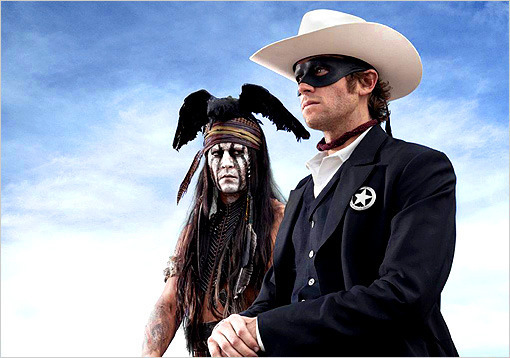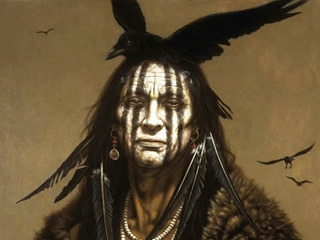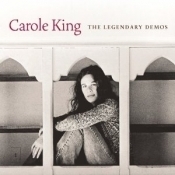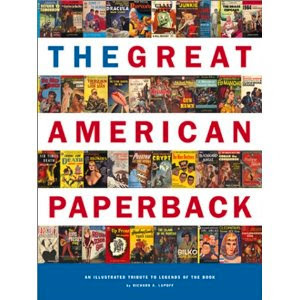Ed Gorman's Blog, page 162
April 27, 2012
Johnny Depp reveals origins of Tonto makeup from 'The Lone Ranger' -- E
 Johnny Depp is no stranger to unfamiliar faces — but what exactly is the origin of his black-and-white painted warrior in The Lone Ranger?
Johnny Depp is no stranger to unfamiliar faces — but what exactly is the origin of his black-and-white painted warrior in The Lone Ranger?
The actor has a penchant for disappearing beneath heavy makeup and elaborate costumes in everything from Edward Scissorhands to Charlie and the Chocolate Factory, Alice in Wonderland, and the upcoming vampire comedy-thriller Dark Shadows.
It was clear from this first photo of Depp and Armie Hammer, released from The Lone Ranger set last month, that Depp was sticking by his word to make this Tonto a radical departure from the Jay Silverheels performance on the 1950s era TV show.
While there has been wild speculation about where Depp took his visual cues (including a theory he was mimicking Marilyn Manson), Depp tells EW about how he actually developed the look, and we reveal the image that inspired him.
GET MORE EW: Subscribe to the magazine for only 33¢ an issue!
“I’d actually seen a painting by an artist named Kirby Sattler, and looked at the face of this warrior and thought: That’s it,” Depp said in a recent interview. “The stripes down the face and across the eyes … it seemed to me like you could almost see the separate sections of the individual, if you know what I mean.”
Well, not really … Separate sections of the individual?
Depp explained that the lines of paint on the Native American’s face looked to him like a cross-section of the man’s emotional life. “There’s this very wise quarter, a very tortured and hurt section, an angry and rageful section, and a very understanding and unique side. I saw these parts, almost like dissecting a brain, these slivers of the individual,” he said.”That makeup inspired me.”
You can see more of Sattler’s work here: http://kirbysattler.sattlerartprint.com/
 The painting also provided inspiration for Tonto’s headdress. “It just so happened Sattler had painted a bird flying directly behind the warrior’s head. It looked to me like it was sitting on top,” Depp said, which led him to another eureka moment. “I thought: Tonto’s got a bird on his head. It’s his spirit guide in a way. It’s dead to others, but it’s not dead to him. It’s very much alive.”
The painting also provided inspiration for Tonto’s headdress. “It just so happened Sattler had painted a bird flying directly behind the warrior’s head. It looked to me like it was sitting on top,” Depp said, which led him to another eureka moment. “I thought: Tonto’s got a bird on his head. It’s his spirit guide in a way. It’s dead to others, but it’s not dead to him. It’s very much alive.”
The title of Sattler’s original work is “I Am Crow,” and although there are Crow peoples native to the northern part of the American Midwest, Sattler says his paintings are not meant to refer to specific tribes. In the new film, Tonto is technically a full-blooded Comanche, and Depp identifies in real life as part Cherokee and Creek Indian, based on a Kentucky great-grandmother’s ancestry, so the character is proving to be less historically specific to one tribe than a blend of various cultures and influences.
Sattler himself, who licensed the look of his painting to the filmmakers, tells EW his work is a fusion of history and fiction. “The portraits I paint are composites created from a variety of visual references coupled with my imagination,” he says. “While being broadly based in a historical context, my paintings are not intended to be viewed as historically accurate. I used the combination of face paint and headdress as an artistic expression to symbolize the subject’s essence and his affinity to the Crow.”
The American Indian community has been divided over Depp’s Tonto. Leaders from the Navajo Nation visited the Monument Valley set and expressed support for Depp and the filmmakers, and Dana Lone Hill, a writer who identifies as part Lakota, penned an essaysaying she intended to give him the benefit of the doubt on adapting the character, since Depp is known for his fanciful and exaggerated performances.
In another column titled “Why Tonto Matters,” Native Appropriations blogger Adrienne K. expressed the frustration echoed by some other Native Americans over Depp’s characterization, saying there are too few authentic portrayals of Native people in pop culture to accept a highly fantasized version.
For his part, Depp has said his motivation to play the character came from disliking how Tonto was relegated to subservience in the old Clayton Moore/Jay Silverheels TV series. While the look may not be historically authentic, Depp wants Tonto’s character to be honorable and self-reliant.
“The whole reason I wanted to play Tonto is to try to [mess] around with the stereotype of the American Indian that has been laid out through history, or the history of cinema at the very least — especially Tonto as the sidekick, The Lone Ranger’s assistant,” Depp told EW. “As you’ll see, it’s most definitely not that.”
The Lone Ranger, directed by the original Pirates of the Caribbean filmmaker Gore Verbinski and produced by Jerry Bruckheimer, opens May 13, 2013.
Read More:
April 26, 2012
Forgotten Books: American Murders ed. by Jon and Rita Breen
In 1986 Jon and Rita Breen edited a fine anthology called American Murders which reprinted 11 short novels from the American Magazine(1934-1954). By now I've probably read and reread it cover to cover four or five times. For me it's literary time travel.
My favorites are those short novels published during the war years. I suppose this is true because they tally with my first memories of--everything. Dads abroad at war, Moms struggling with jobs and kids and ration books and the fear of a uniformed man knocking on the door with bad news. And popular culture of every sort vibrant and vital with propaganda.
One of the great war-time images in the Breen anthology occurs in "Murder Goes To Market" by Mignon Eberhardt. She writes of going shopping with her ration book to a then-new concept known as a Supermarket. The way she describes this place is almost science-fictional. My God--aisles! Shopping carts "that look like perabulators!" And the choice of "(carrying) your loot away in a paper bag or in a market basket or (letting) a boy carry it for you." Zounds!
This reminds me of the way John D. MacDonald highlighted air-conditioning so often in his pulps stories of the Forties and his early paperbacks of the Fifties. A revolution was at hand!
F. Paul Wilson once noted that detective stories give us "snapshots" of an era better than any other kind of fiction. I certainly agree.
For my blog readers: I apologize for the physical messiness of the posts lately. I don't know what happened. But I've hired a very smart woman to look into it. Hopefully I'll be back to my NORMAl messiness soon.
April 25, 2012
In Pursuit of Spenser edited by Otto Penzler
A Tribute to Robert B. Parker and His Greatest Creation: Spenser [image error] PAPERBACK
 Buy From Us
Buy From Us Amazon
Amazon Barnes & Noble
Barnes & Noble Indie BoundE-BOOK
Indie BoundE-BOOK Buy From Us
Buy From Us Kindle
Kindle NookIn Pursuit of Spenser
NookIn Pursuit of SpenserMystery Writers on Robert B. Parker and the Creation of an American Hero
EDITED BY OTTO PENZLEREmail—Joan ParkerJoin award-winning mystery editor Otto Penzler and a first-rate lineup of mystery writers as they go in pursuit of Spenser and the man who created him, Robert B. Parker. These are the writers who knew Parker best professionally and personally, sharing memories of the man, reflections on his impact on the genre, and insights into what makes Spenser so beloved.
Ace Atkins, the author chosen to take up Parker’s pen and continue the Spenser series, relates the formative impact Spenser had on him as a young man; gourmet cook Lyndsay Faye describes the pleasures of Spenser’s dinner table; Lawrence Block explains the irresistibility of Parker’s literary voice; and more. In Pursuit of Spenserpays tribute to Spenser, and Parker, with affection, humor, and a deep appreciation for what both have left behind.
Includes a reprinted piece on Spenser from Robert B. Parker
 READ EXCERPTSIntroduction: In Pursuit of Spenser
READ EXCERPTSIntroduction: In Pursuit of SpenserOtto PenzlerSongs Spenser Taught Me
Ace AtkinsVoice of the City
Dennis LehaneThey Like the Way It Sounds
Lawrence BlockSpenser’s Code of Humor
Parnell HallParker and Spenser: A Collaboration
Loren D. EstlemanBob, Boston, and Me: A Remembrance
Jeremiah HealyA Man for All Seasonings
Brendan DuBoisSpenser and the Art of the Family Table
Lyndsay FayeLooking for Hawk
Gary PhillipsWho is Silverman, What is She?
S.J. RozanA Look at Spenser: For Hire
Matthew Clemens, Max Allan CollinsGo East, Young Man
Reed Farrel ColemanParker Saddles Up
Ed GormanSpenser: A Profile
Robert B. Parker
April 24, 2012
The latest Dead Man novel is out now, and it's a good one!
The latest Dead Man novel is out now, and it's a good one! Grab a copy!
Amazon.com: Freaks Must Die (Dead Man #10) eBook: Joel Goldman, Lee Goldberg, William Rabkin: Kindle Store : When Matt Cahill intervenes in what he thinks is a robbery, he ends up botching a ransom exchange for a kidnapped boy. His interference gets an innocent man killed and puts a child’s life in immediate jeopardy. So Matt heads to New York City, a place as foreign to him as a distant planet, to rescue the boy and make amends.
His search leads him to an underworld of “freaks,” people with uncanny powers who live in the shadows, trying to elude a dark force that’s ruthlessly hunting them down. Now Matt is in a race against time to save a child, and the entire freak community, from bloody annihilation.
[image error]
I'm a big big Carole King Fan
Carole King Review: 'Legendary Demos' Honors a '60s Recording Career That Never WasPublished: April 24, 2012 @ 10:33 amPost a CommentPrint This Page00
inShareBy Chris Willman
Listening to Carole King's "Legendary Demos," you enter an alternate pop universe where her stardom didn't begin with 1971's "Tapesty" but actually got under way a decade or so earlier, with King herself enjoying the spoils of her songwriting instead of giving her hits away to everybody from the Shirelles and Righteous Brothers to Aretha Franklin.

It's a fun exercise in "What if...?" -- and maybe a slightly wistful one, since "Legendary Demos" makes you feel that maybe we lost something by not having King kick off her recording career until 10 years after she'd established her writing career. She could've been a great 1960s hitmaker; the mystery is why no one forced her Jane Hancock onto a recording contract years sooner.
The collection starts with the song you might least imagine King singing -- the Monkees' hit "Pleasant Valley Sunday," the jangly sound of which never became part of her wheelhouse. (The lyrics, as with most of her early tunes, were by then-husband Gary Goffin, who was waxing sarcastic about the New Jersey suburbs King had moved them out to from Manhattan.)
For anyone who thinks "demo" will be synonymous with "girl alone at her piano," the full-band arrangement of "Pleasant Valley Sunday" comes as a pleasant surprise, and several other numbers follow suit. The most elaborate, "Like Little Children," is a full-blown pop/R&B recording with horns and female backing vocals that wouldn't give you a moment's pause if someone snuck it onto an oldies station.
Tracks that do consist of just King at her piano are just as delightful, including the earliest, a 1961 take of "Take Good Care of My Baby" (a Bobby Vee hit) that has King blueprinting the most interesting parts of the eventual arrangement with just one set of keys. On "Crying in the Rain" (a 1962 Everly Brothers smash), vocal overdubs turn King into a one-gal girl group.
The track list might initially seem slightly disappointing, if your hope is to hear King singing tunes that were only famously recorded by other artists. For instance, there's no "Will You Still Love Me Tomorrow," since, as the liner notes explain, the vocals for that particular demo were recorded by the Shirelles, not King.
Six of the 13 tracks here eventually ended up re-recorded for "Tapestry," but that doesn't make the album feel overly familiar, since some of the arrangements here are very late-'60s-period-specific. You could put her 1967 version of "(You Make Me Feel Like) A Natural Woman" up against the one she released four years later -- or, to be potentially blasphemous, against the one Aretha had a hit with that year.
And "Way Over Yonder" is indisputably better than its "Tapestry" update, since the slower, more soulful feel better reinforces that this nice Jewish girl was trying her hand at gospel.
Is it ever too late to get a terrific, newly recovered proto-version of "It's Too Late"? Not often are we graced with the equivalent of a great lost 1960s album that's finally being liberated from the vaults, which makes "Legendary Demos" a time capsule that's particularly easy to swallow.
[image error]
April 23, 2012
A Free Bill Crider novel FREE on KIndle Today!
Free Today for Kindle!

Amazon.com: The Prairie Chicken Kill
(Truman Smith Mystery Series) eBook: Bill Crider: Kindle Store
Even if you don't want to read it, please take advantage
of the free download. Every downloaded book makes
Amazon think better of me. Thanks!
April 22, 2012
Noir Poets: W R Burnett
“And suddenly Roy didn’t give a damn about Velma, or about Pa and Ma. He realized that they had never been real people to him at all, but figments out of a dream of the past. He began vaguely to understand that ever since the prison gate clanged shut behind him he’d been trying to return to his boyhood, where it was always summer and in the evenings the lightning-bugs flashed under the big branches of the sycamore trees and he swung on the farm gate with the yellow-haired girl from across the road while the Victrola on the porch played Dardanella. . . . Pa and Ma were replicas of his own folks merely, and Velma wasn’t really Velma, a slim, ordinary little blonde, but the ghost of Roma Stover, the yellow-haired girl swinging on the gate. . . .”
W. R. Burnett – High Sierra (1940)
http://filmsnoir.net/film_noir/noir-poets-w-r-burnett.html#ixzz1snXHRV8
Read more: http://filmsnoir.net/film_noir/noir-poets-w-r-burnett.html#ixzz1snXHRV8J
Under Creative Commons License: Attribution
April 21, 2012
Forgotten Books: In Dubious Battle
Forgotten Books: In Dubious Battle by John SteinbeckIt's bracing to remember, in this time when mega-corporations control our lives, to recall a time when people fought back against those who enslaved them.
In Dubious Battle by John Steinbeck, a novel I prefer to the preachy and over-calculated Grapes of Wrath, is set in a tiny California town where apple pickers are angry at the growers' association for cutting wages by fifteen cents. The year is 1936 and the forces of the rich and powerful are at war with the powerless workers. Mac and Jim are the lead characters and it is Mac who takes Jim to a meeting of the Communist Party, which wants to convince the workers to strike. They are joined by Doc Burton, a medical man who keeps the worker camp clean so that the cops can't close the place down because of sanitation violations.
Steinbeck's passion can be found on every page, in every detail. The camp and its people are depicted realistically. Steinbeck is not writing a tract. Some of the workers are here just to make trouble; others are stalking horses for the Communists. Others for the growers' association. The poverty, the despair and above all the rage are palpable. As is the sorrow.
For me Jim is the most interesting character in the book because he changes over the course of his experiences. He begins to see that the concept of "the working man's friend" is a lie. The Communists exploit the workers just as the Capitalists do. Doc has his vision of how things should be; Mac believes in political movements; but Jim finds no comfort. The misery he has seen in his years seems a brutal and irrefutable fact of life.
Steinbeck was long ago judged as second-tier to his enemy Hemingway. I never quite knew why. Good as he was, Hemingway could not have painted on a canvas this large and done it with such grace and power. You'll never forget the people you meet here.
April 20, 2012
I Will Not Read Your Fucking Script
I Will Not Read Your Fucking ScriptEd here: Thanks to Bill Pronzini for the link.
By Village Voice contributor
published: Wed., Sep. 9 2009 @ 10:00PMWe know you've been working very hard on your screenplay, but before you go looking for some professional feedback, you might keep in mind the following piece by A History of Violence screenwriter Josh Olson. Copyright Josh Olson 2009
[image error]I will not read your fucking script.That's simple enough, isn't it? "I will not read your fucking script." What's not clear about that? There's nothing personal about it, nothing loaded, nothing complicated. I simply have no interest in reading your fucking screenplay. None whatsoever.
If that seems unfair, I'll make you a deal. In return for you not asking me to read your fucking script, I will not ask you to wash my fucking car, or take my fucking picture, or represent me in fucking court, or take out my fucking gall bladder, or whatever the fuck it is that you do for a living.

April 19, 2012
Forgotten Books: The Great American Paperback by Richard Lupoff
 AAmazon.com ReviewPenzler Pick, October 2001: There may be some irony in the notion that a book devoted to paperbacks (the most inexpensive book format--small, easily transportable and disposable) is a huge, expensive, beautifully produced hardcover volume that is certain to be a gem in any collector's library.
AAmazon.com ReviewPenzler Pick, October 2001: There may be some irony in the notion that a book devoted to paperbacks (the most inexpensive book format--small, easily transportable and disposable) is a huge, expensive, beautifully produced hardcover volume that is certain to be a gem in any collector's library.For several centuries books in America customarily were pages bound between hardcovers and, in this century, had dust jackets wrapped around them, initially just to protect the cloth covers, but eventually as an attention-grabbing advertising poster.
In 1938, an experiment was launched. The cloth cover was exchanged for a paper one, and the colorful illustration and information that appeared on the dust jacket (author, title, publisher, a few lines about the book) was printed directly onto those paper covers. Cheaper paper was used, since these artifacts were no longer expected to form part of a permanent library, but were to be as disposable as a newspaper or magazine. And they were cheap: a 25-cent price made books affordable for a huge portion of the population. They became immeasurably successful almost overnight.
Today many of those books are highly sought-after collectors' items. In spite of the huge numbers printed, they are scarce now simply because almost no one ever thought to save them in colorful, pristine condition. The Great American Paperback illustrates in glorious full color more than 600 of the most interesting and collectable paperbacks, each with an informative caption that provides as much fascinating anecdotal information as the text, which is a masterly and scholarly history of the American paperback, tracing its roots to the early 19th century and concluding with a look at the future.
There are samples of the paperback originals of Ed McBain, Richard Stark, Jim Thompson, Harlan Ellison, and James M. Cain, as well as illustrations of such rarities asThe Maltese Falcon, which was issued as a paperback with a dust jacket, and Ellery Queen's Halfway House, which was offered in two formats by the publisher, one bound the usual way, the other bound at the top edge.
If this massive work hadn't been produced in Hong Kong, it would have cost twice as much and is, believe it or not, a bargain, even at a price as hefty as the book itself. --Otto Penzler
Ed here: Dick Lupoff has distinguished himself as a writer of both mystery and science fiction and fantasy. He has also been and editor and biographer of great renown. I first heard of him when he and his lovely wife Pat began publishing the legendary science fiction/comic book XERO back in the early 1960s. If you'd like to know (or remember) what genre fiction as all about in that lost age I suggest you but the hardbound collection of XERO's including Donald E.Westlake's scorching goodbye to his science fiction career.
But this magnificent history--because it's nothing less--of paperbacks books in America would be enough to make you well known and respected. The covers are knock-outs and the text is packed with stories and tales of writers and editors and publishers are told with Dick's usual wit, high style and erudition.
There are many books about paperbacks but I can't think of any that come even close to this sprawling, hilarious, melancholy, fact-packed tribute to the highs and lows of American publishing.
This is a singular accomplishment and Dick Lupoff should be honored for it.
Ed Gorman's Blog
- Ed Gorman's profile
- 118 followers




